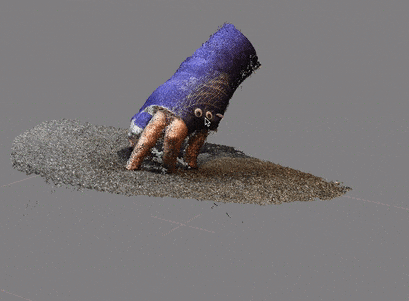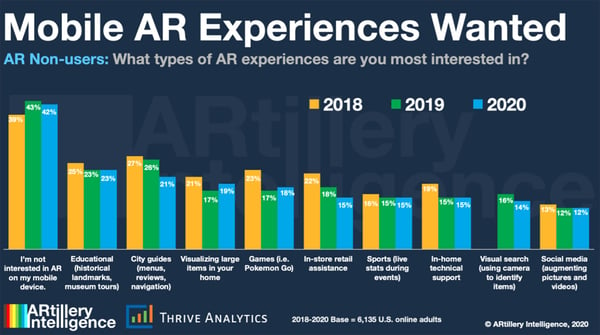Augmented reality is a fantastic tool for engaging marketing and advertising. It's also a medium to immerse audiences to brand content. But, behind these great words, what is it all about? How can anyone experience it? How do you create it? What can it be used for?
Read on, and we'll answer all your questions! And if not, you can always leave a comment or a question, and we'll dive into that.
So, what is augmented reality?

The simplest explanation is that it's a digital layer of content added to the physical world. AR content becomes visible, hearable, feelable, or even smellable through an AR-enabled device, such as AR glasses or regular modern smartphones.
AR is not for you to drift away into some other dimension with blocking goggles. AR's goal is to enhance our world: to enable us to utilize our surroundings more effectively. With AR, you'll see your world from a different perspective while still being wholly present.
AR was first introduced to the world in the early 1990s with the Virtual Fixtures system in the US Air Force. Slowly but surely, AR crawled into sports broadcasts, NASA's operations, and finally into the applications we know today: gaming, education, communications, medical, and entertainment. Now AR is pushing its way into other industries and applications as well, and probably the most hyped ones at this time being advertising and marketing.
Find out more about augmented reality basics from our AR for beginners -post.
Why is augmented reality better than virtual reality?
Augmented reality can easily get confused with virtual reality (VR), but there are significant differences. The most crucial ones are visual, device, user, experience, access, and content differences.
The combining aspect of these differences is that AR is interactive, social, and easier to access. VR allows you to explore other worlds and is excellent for visiting different dimensions. VR transfers you from this reality to another, while AR gives you a new perspective on this life. AR delights and immerses while allowing you to stay present.
While VR can give you fantastic experiences and opens the possibility to visit other worlds, AR is something to better the only planet we truly have. Also, VR is seen as something for entertainment when AR is expected to have a more practical function (source: ARtillery Intelligence AR user research, Spring 2020).
Dive deeper into why augmented reality is better than virtual reality.
How to create AR?
When you're planning on adding augmented reality into your marketing, advertising, or brand-building tool mix, there are a few things to consider.
The first thing to do is to define your concept and goals. Whether you want to approach your audience with the most-wanted AR applications or something entirely different, step into your audience's shoes. What are you trying to achieve, and what would delight your customers?
After having a clear concept in mind, the next thing is storytelling. With AR, you can tell a story that is engaging and immersive. The key to immersive storytelling is interaction. Augmented reality can offer an emotional impact; use it to your advantage.
To transform your message into an augmented reality story, you need virtual objects. They can be photos, videos, and 3D models or sound, motion graphics, captured data, and so forth. But of course, the best results come from materials specially designed for your AR experience.
AR should add to the physical world. Be it location-based experiences or AR attached to a surface, the best experiences utilize their surroundings to their advantage. Think in 3D and add to the physical world.
Check for more on how to create augmented reality: 6 tips to rock your AR content.
Create AR content without coding and 3D modelling - what is photogrammetry?
Photogrammetry is a technology for making measurements from photographs. These measurements can then be used in making the images into digital (3D) content. With photogrammetry, you can add more texture and features to an object than reasonable with traditional 3D modelling or possible with 3D scanning.

Photogrammetry is low-cost. You don't necessarily need high-quality equipment for the pictures; your smartphone is enough. Compared to LIDAR or some other 3D scanning, the tools required are much less demanding. And, building the AR content entirely by hand is on a whole different level. Of course, if your content is simple enough or doesn't need to be that accurate, or maybe even is something that doesn't exist in the real world yet, 3D modelling is a valid way to go.
Unlike when creating your 3D content by hand, photogrammetry is way faster. Even if your object requires hundreds, or even thousands, of pictures, the conversion takes less time than building the object in 3D from scratch.
Interested in learning more about photogrammetry? Read our full post on creating AR with photogrammetry.
AR technology
To experience AR, you need an augmented reality device. Depending on the use case, it can be a haptic suit or other clothing pieces, AR glasses, or contact lenses in the future, or a smartphone.
In addition to the AR device, you need an AR application to explore AR content. Again, depending on the content, the application can vary from an individual app to just your smartphone's browser. Browser-based AR, or WebAR, has a key position in offering seamless and accessible AR experiences for all.
Find out more about browser-based augmented reality from our WebAR basics blog post.
Depending on the AR content, you might need a trigger or a target image in the physical world to launch the experience, but that's not always the case. How an AR with trigger works is that you point your device's camera to the trigger, and the AR content opens from it. If no trigger is needed, you just open either the AR app or your browser to a specific link, and your AR content appears.
The decision on whether to use an app or WebAR in your AR campaign depends on the content. An app offers more computing power for more complex and high-quality content, whereas WebAR's reach can be higher.
AR wearables
With an increasing amount of AR content, there is a growing need for AR wearables. AR glasses have been coming on for several years now. However, there are still no actual wearable glasses for the vast audience. Other AR wearables are even further away from hitting the market.
But, when the AR and smart glasses do launch to the consumer market, the amount of AR usage will explode.
What's the status of AR wearables now? Check out our breakdown of the state of smart, AR, and MR glasses in 2021.
How can your business benefit from augmented reality?
AR goes well with countless use cases: from healthcare to warehouse, vehicle building to navigation, tutoring to marketing. AR will become an essential part of our lives in the future, as the spatial internet is being built. In the spatial internet, or the AR Cloud, the Magicverse, the Mirrorworld, the Metaverse, AR is all around us, aiding us in finding the relevant information at the right time.
Meanwhile, AR can offer a significant improvement in reaching and nurturing customers. AR is a medium where people want to spend time and interact with brand content.
Shift from digital to AR marketing is nigh - stand out from the noise
Spatial computing is doing for digital marketing what banner ads did for traditional marketing. The shift from 2D to 3D is the next step all today's marketers are facing.
AR is offering new ways for all marketers to reach, engage, and understand their audience. With AR content, you'll allow your customers to see your product's or service's benefits in their world. Instead of telling how your sneakers are better than the competing ones, you can show them.
Your marketing acts are the first thing your audience will see, and we all know the importance of first impressions. So, you might consider making your first impression something to remember. Augmented reality can help make such a simple thing as a banner ad into a memorable brand experience.
Re-cap: augmented reality is a business superpower. Use it now.
With AR, you can offer your customers experiences that have never been possible before. They can see things that haven't been visible, and hear things that haven't been heard before. These new kinds of experiences will elevate you and your brand to a position where your prospects want to hear and see more from you.
There is a new place for trailblazer businesses in the union of the physical and the virtual. That place is AR.



